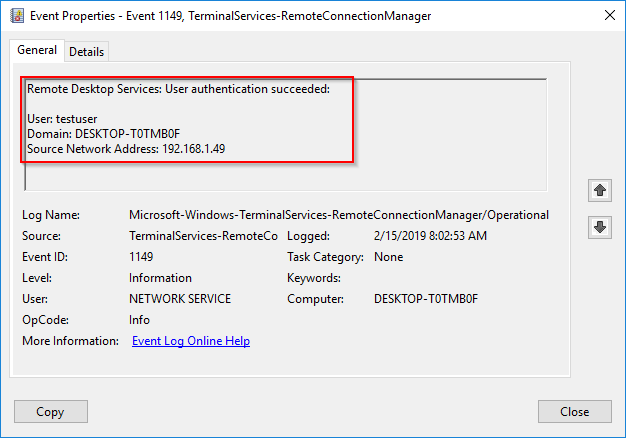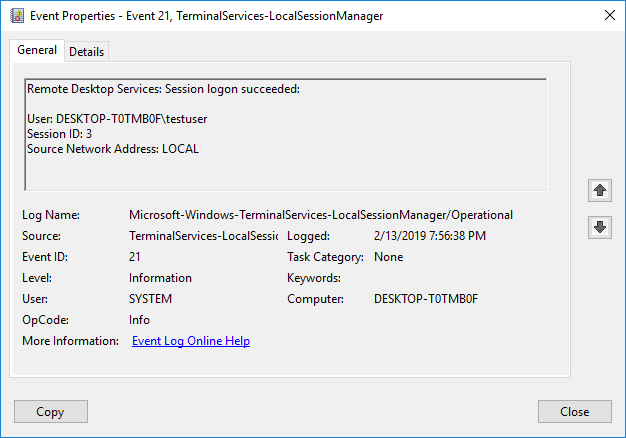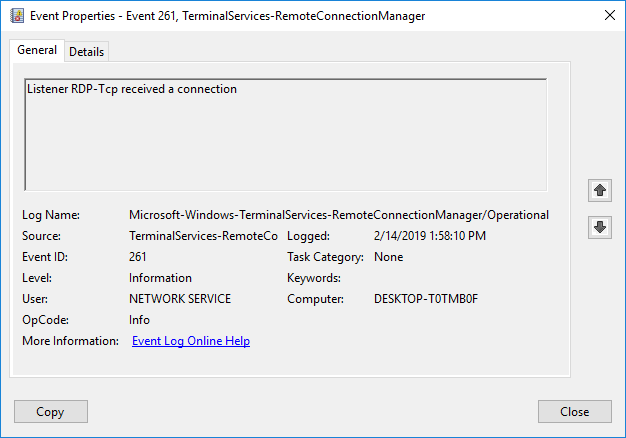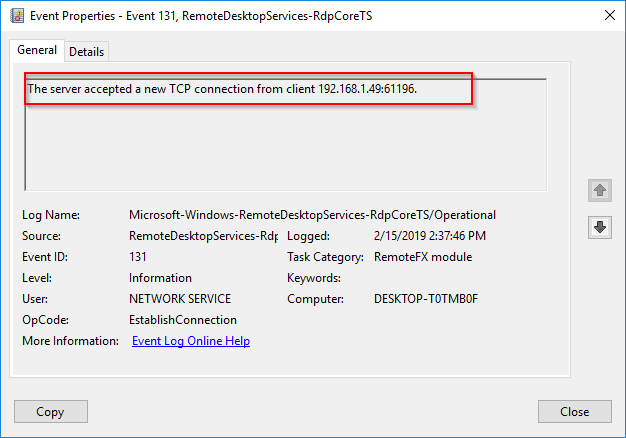A good detection technique to spot Remote Desktop Connections that are exposed to the internet is to scan RDP event logs for any events where the source IP is a non-RFC 1918 address. This provides you a good way to check for locations that may be port forwarding RDP, like work from home users.
During a recent investigation involving Remote Desktop Connections, I discovered some behavior that limited this search functionality and was contrary to what I’d observed in previous cases and seen documented in other blogs. I’ve done some testing over the last few days and thought I’d pass along what I’d found.
Prior Observations
I refer to the following two sources whenever I need a refresher on RDP logging. They both do a great job of explaining what gets logged at the various stages of an RDP connection: Login, Logoff, Disconnect, Reconnect, etc.
- https://ponderthebits.com/2018/02/windows-rdp-related-event-logs-identification-tracking-and-investigation/
- https://www.13cubed.com/downloads/rdp_flowchart.pdf
During previous investigations, I’d observed Event ID 1149 in the TerminalServices-RemoteConnectionManager/Operational log occurring as soon as an RDP connection was established. This event was logged prior to credentials being entered during the login process and my interpretation was that this indicated that the RDP client has connected to the RDP host successfully. It did not indicate that a login had successfully occurred.
This made Event ID 1149 very valuable as it gave you the means to spot failed logins or brute force login attempts even if auditing of failed logins was not enabled. As mentioned above, the presence of a non-RFC 1918 address in one of these logs is a good indicator that that device has been in a location with RDP exposed to the internet.

Event ID 1149 was followed by a series of other events which varied depending on whether a previous session was being reconnected and whether the authentication was successful.
During successful authentication, you observe Event ID 4624 in the Windows Security log. Note there is a 4624 event where the “Logon Type” is 3. This occurs because this connection is using Network Level Authentication. This will be followed by another 4624 Event with logon type 10 (or 7 for reconnects). (*Thanks to @securitycatnip for catching an error in the original post.)

Event ID 21 and 22 (new connections) are logged in the TerminalServices-LocalSessionManager/Operational log.

For failed logins, Event ID 1149 would be followed by Event ID 4625 in the Windows Security Log.

An important point is that Event ID 4625 ( for login failures) is not logged by default in desktop operating systems like Windows 7/8. Recent versions of Win 10 have these enabled by default.
Current Observations
During a recent investigation, I noticed that Event ID 1149 was not being logged when the login was unsuccessful. This was observed when connecting to a Windows 10 device. If the login succeeded, the 1149 event was logged as seen previously. In both cases, Event ID 261 is logged in the TS RemoteConnectionManager/Operational log but unfortunately, this doesn’t give us any information on who was attempting to connect.

After performing some additional testing and reviewing notes from previous cases, I’ve found the following. Please note, not all Operating Systems or OS versions are accounted for here as I tested what I had available.
Event ID 1149 was not logged prior to successful authentication and only occurs if authentication is successful on the following Operating Systems:
- Windows Server 2012
- Windows Server 2016
- Windows 7
- Windows 8.1
- Windows 10 (version 1803)
Event ID 1149 was logged prior to successful authentication on the following Operating Systems:
- Windows Server 2008
- Windows SBS Server 2011
Additional Log Sources
I performed a timeline of the Event Logs after a series of failed and successful RDP connections to see if anything else was logged that might be helpful in identifying failed RDP login attempts. I discovered that the RemoteDesktopServices-RdpCoreTS/Operational log does log Event ID 131 when the RDP connection is first established. This occurs prior to authentication like Event ID 1149 did previously and while there is no workstation name or user account associated with this log entry, it does provide the connecting IP. Unfortunately, this log channel does not exist in Windows 7.

I touched on Network Level Authentication above when discussing the “Logon Type” field recorded in the Security log. NLA requires the client to authenticate before connecting to the host. An easy way to tell if NLA is disabled is that when connecting to a host, you see the login screen of that device before entering credentials. This allows an attacker to see who is currently logged in, other user accounts on the PC and the domain name.
NLA really should be enabled on most devices but if it is not, you can find an additional event in the TerminalServices-RemoteConnectionManager/Admin log. Event ID 1158 will also display the source IP. While this log is available in Windows 7, I was not able to generate Event ID 1158 when connecting to a Windows 7 PC without NLA.

Closing
One final tip. If you’re doing any RDP testing and want to force your client to connect without NLA, you can do so by editing the RDP connection file. To do so, save the .RDP file and open it in notepad or another text editior. Paste the following line anywhere in the file:
enablecredsspsupport:i:0
If you’ve got any feedback, feel free to share. I’m still on the lookout for a good way to identify brute force RDP attempts on default Windows 7 configurations so if you’ve got any thoughts on that, let me know.
A couple of additional tidbiits:
1 – For Win7 RDP clients, the 8.0 RDP protocol update has broken logging of the client IP address on the target system. As a consequence, this address is typically set to 0.0.0.0. See https://support.microsoft.com/en-us/help/3097467/invalid-client-ip-address-in-security-event-id-4624-in-windows-7-and-w?language=en_US%3Flanguage%3Den_US
2 – In some cases where pass-the-hash is employed, the Workstation Name value will be set to a randomized 16 character value in events logged on the target host. I’m not positive, but I think this is characteristic of the metasploit pass-the-hash code, and that a client can actually pass an arbitrary string in this field.
LikeLike